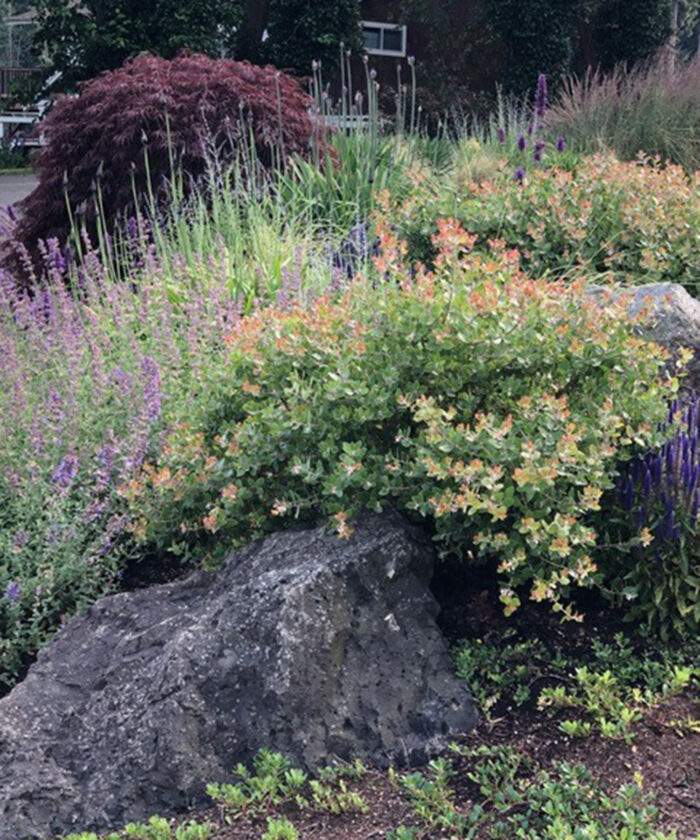
One thing that we Northwest gardeners need to start thinking about more and more is how to protect our homes from wildfires. Most gardeners in the Northwest have always expected that the moisture, low heat, and plentiful shade in our region would protect us from fire. Recently, however, we found our complacency shaken. Wildfires in Oregon, Washington, and British Columbia have not only struck the dry areas of our region on the eastern side of the mountains but also those on the western sides as well.
WUI is an acronym for wildland-urban interface. These are areas at the edges of urban development close to the wild lands that can be prone to fires. In the WUI, gardeners need to be aware of the dangers of wildfires. Many of my clients like to live on the edge of the forest where they can have privacy and be close to nature. As we face the emerging possibility of fire danger, it is time to do a few essential things to minimize the threat to our homes, neighbors, and the firefighters that will come to protect us in the event of a potential fire.
Basic principles of firewise planning
Good garden design needs to take into account the three main components of firewise gardening. The first one is building a defensible space around the house and other buildings. The second is adding fire-resistant mulches, hardscapes, and plants. The third is proper maintenance for the garden, which will deter fire. There are many combinations of these components, and the design process can be reasonably complex, but for today, I will go over how one would make a landscaping plan with these principles in mind.

5 to 10 feet from the house: Clear space
Planning out the first 5 to 10 feet of the area closest to the house should be one of the most important parts of your landscaping. It is best to have nothing that will burn in this space, including bark mulch, shrubs, trees, or even wooden patio furniture. A deck is also considered part of the house by these metrics, so creating that defensible space should also include the 5 to 10 feet around the deck. Above is a design for a firewise garden in the Lake Chelan area of Washington. Fire danger there is extreme. Hot, dry summers and not a lot of moisture make it essential to plan a yard safe from danger. The danger comes from flying, burning debris (firebrands) that can land on a house, deck, or the ground around a house or structure. Rock mulch, ground covers, turfgrass, and herbaceous plants can be beautiful, and they are safer than many alternatives.
10 to 30 feet from the house: High-moisture plants
Between 10 and 30 feet away from the structure, you can use more shrubs, some trees at a specified distance apart (think 10 feet from the edge of crown to crown), and additional hardscapes and structures. Use open-branched plants and plants with high moisture content. Don’t use resinous plants and trees such as pines (Pinus spp. and cvs., Zones 3–8), firs (Abies spp. and cvs., Zones 3–8), junipers (Juniperus spp. and cvs., Zones 2–9), and spruces (Picea spp. and cvs., Zones 3–8). Turfgrass, some species of ornamental grasses, evergreens, and deciduous shrubs are all good choices. Pathways, rock walls, and hardscape features also provide firebreaks in case a fire does break out. Dry stream beds and streams for water features are also beautiful and can provide nonflammable surfaces.

30 to 100 feet from the house: Increased maintenance
Working on the next section is a little more about maintenance. Make spacing between trees more generous here. You can add space between shrubs with acceptable pruning practices along with removal of loose grasses, weeds, and leaves from beds to reduce fuel for fires. Many properties do not have the 30-to-100-foot section and may have to look to the neighboring properties to determine what the planting plan looks like there. Neighborhood awareness is important so that everyone can get on the same planting plan. Many communities in WUI have started to develop awards and group efforts to encourage firewise plantings.

Firewise plants
Plant lists are available that give useful information about flammability, dwarf plants, and actual fire-resistant plants like Dura Heat® river birch (Betula nigra ‘BNMTF’, Zones 4–7). One of my favorite firewise plants is native manzanita (Arctostaphylos manzanita, Zones 7–9), which is actually fire dependent, meaning that it needs to go through fire to regenerate. Another great pick is fireweed (Chamerion angustifolium, Zones 2–9), which is an evergreen, purple-flowering perennial that has beautiful foliage, bark, and tiny flowers. A third pick is native bear grass (Xerophyllum tenax, Zones 4–8), which has a great root system that is very fire resistant. It’s also an evergreen that produces masses of white flowers.
There are many resources available for homeowners and professionals. Firewise USA Program is a project of the National Fire Protection Association, with information about firewise gardens available in Oregon, Washington, and Idaho. The Washington State University Extension program has a lot of information, including plant lists and methods. British Columbia has good information available from BC FireSmart Committee established in 2017. You can also read more about firewise landscaping in the following articles:
- Firescaping and Wildlife Recovery: An Interview with Douglas Kent
- Firewise Landscaping: How Safe Is Your Home?
Awareness of the possibility of wildfires in our own backyard is important. With good plant choices, regular maintenance, and well-placed hardscapes, there are many ways to create a beautiful, functional garden.
—Susan Calhoun is the owner of Plantswoman Design in Bainbridge Island, Washington.


















Comments
Log in or create an account to post a comment.
Sign up Log in